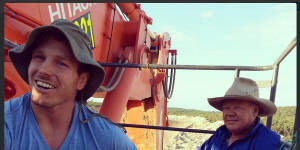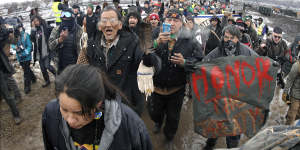How are environmental protests changing (and do they work)?
Ella Simons was 13 and sleeping in the shadow of a mountain when the fire alarms went off. It was the dead of night,just three days into 2020 but already months into a horror bushfire season. Ella had been camping near Mansfield with a youth group. Now the smoke was choking,and the black sky streaked orange as the fire advanced. Seven-year-olds ran past her,crying,coughing. Ella followed them onto the bus.
For much of that past year,she’d been organising protests in Victoria as part of the global “school strike for climate” movement – wrangling police permits and speaker line-ups between classes and soon drawing crowds bigger than any seen before at an Australian protest. “The scientists had been saying these fires were coming and,suddenly,here they were,” Ella says. “It was terrifying.”
A year later,she found herself in Mallacoota as part of a bumper-to-bumper convoy of travellers rushing to beat pandemic lockouts at the Victorian border. “The trees were still black where the fires went through,” Ella says. But she could see green shoots sprouting up through the dirt too,clinging to the bark. Thousands of them. “I thought,wow,nature is fighting back. We’ve lost all this momentum during COVID but we can’t forget what happened that summer.”
David Ritter,chief executive of Greenpeace Australia Pacific has been thinking a lot about regeneration too,about the seeds buried so deep only a firestorm can unleash them. “Those seeds are still there after COVID,they’re growing. The school strikers have re-energised the entire climate movement.”
Last month,Ella turned 15 the same day she hopped on a plane to Milan to represent Australia at the UN’s youth climate summit ahead of COP26. Young people came from all over the world to draft policy and march in the streets behind Greta Thunberg,the Swedish teen who ignited the climate strike movement in 2019 when she skipped school to protest outside her parliament every Friday. Ella was the youngest delegate there – almost every year of her life has now ranked among the hottest on record. While she shares Thunberg’s frustration with the stagnating political process,she says being with Thunberg and her peers and the thousands of adults from all walks of life now standing behind the school strikers has given her hope. “At school we learn about history. Well,we’ve been creating it too.”
And,Ritter says,the climate movement is learning from it. As Ella and her fellow school strikers gear up for more protests next year,other groups are waking from pandemic hibernation too. That includes Extinction Rebellion (XR),which came to global attention when activists scaled bridges,blockaded roads and shut down much of central London traffic over 11 days in 2019. On the final night,a mural by street artist Banksy appeared depicting a child with the XR hourglass symbol and the words,“From this moment despair ends and tactics begin”. Days later,a UK Parliament under pressure declared a climate emergency.
Before XR,these “direct action” tactics had mostly been used by environmentalists against specific projects (not peak-hour traffic). Non -violent civil disobedience,which draws on the legacies of the suffragettes and the civil rights movement,is polarising,but it has led to big wins in the past. Blockades and protest camps saved the Franklin River in Tasmania from a dam in the 1980s,and in recent years has helped shrink and delay huge coal mines planned for the Galilee Basin in Queensland. When Greenpeace sent one of its ships – the same ships largely credited with saving whales from hunting decades earlier – to the Great Australian Bight off the coast of South Australia,the resulting flotilla of fishermen,traditional owners and concerned locals helped scare off the last of the big companies planning to drill for oil beneath those waters. In 2012,when activists in inflatable boats tried to block the Margiris supertrawler from docking to fish in Australian waters,an eleventh-hour government ban banished the controversial ship just days later. And Greenpeace’s habit of occupying oil rigs at sea created an even more hostile climate for Shell’s Arctic drilling ambitions,which iteventually abandoned after a long opposition campaign.

A Banksy artwork appeared on the final night of Extinction Rebellion’s London blockade in 2019.Credit:Facebook/XR
These wins are not always clear-cut;sometimes they’re short-lived or fraught with danger (Greenpeace’s first ship was bombed by the French secret service). And they almost always take time. In the US,the decade-long campaign tostop the Keystone oil pipeline could have been looked on as a failure right until it wasn’t – President Joe Biden vetoed it in his first days in office.
In that fight,and in many others,Indigenous people have been a driving force. The World Bank calculatesthey safeguard about 80 per cent of all biodiversity left on Earth,and experts say there arebig environmental wins when Indigenous nations manage their land. But Gomeroi woman Karra Kinchela says heritage and native title laws are weak in Australia. Sometimes a nation will not agree on whether to allow development. “It can be used to divide us,or they’ll come in and try and buy us off,” she says.

In 2014,former Wallabies captain David Pocock locked onto equipment with farmer Rick Laird to disrupt work on a coal mine threatening the Leard State Forest in NSW.Credit:Twitter
In her home of Narrabri in NSW,Kinchela is fighting to stop Santos from expanding its gas fields. “This is beautiful country but I’ve seen it change. We’re now surrounded by coal mines and gas fields.” The river where she and her father once swam is clogged with sediment. To drill 850 new gas wells,Santos plans to clear parts of the Pilliga forest,a refuge for koalas,quolls and the rare Pilliga mouse.The whole area also sits on akey recharge zone for the Great Artesian Basin – the mammoth groundwater system that feeds much of inland Australia – drawing concern from farmers about well contamination. The proposal,which Santos says will create local jobs and has careful restrictions around water,drew a record 23,000 community submissions in NSW,almost all opposed. But this year,it wasfast-tracked by the federal government (even before approvals were in) as part of its gas-led COVID recovery. Santos did not respond to requests for comment.
Kinchela says the community is running out of options,but it won’t back down. “Our Country has been hurting from the drought,then the fires. What will be left for us when they come and take what they want?”

The campaign against the Keystone pipeline was driven by First Nations people across the US.Credit:Bismarck/Tribune/AP
How are campaigners following the money?
Damaging the planet is done for profit,so much of modern environmental campaigning focuses on the financials. As Australia ducked calls to up its climate ambition at COP26,Prime Minister Scott Morrison declared that “can-do capitalism” would fix the climate crisis,not government intervention.
He was right in one way. Although nations such as Australia still pour billions of dollars into taxpayer subsidies to the fossil fuel industry,the transition to clean energy is already well under way,says Will van de Pol at Market Forces. Renewables are now cheap andefficient. Already,they make up almost a third of world energy use. The question is whether the phase-out of fossil fuels will happen fast enough to avoid the trillions of dollars (not to mention many lives) that will be lost the further beyond 1.5 degrees of warming we go – and how much companies will extract of the coal,oil and gas reserves that scientists say must stay in the ground.
“That’s why we follow the money:to make sure it’s used as a force for good,” says van de Pol. Just 100 companies worldwide areestimated to have produced about 70 per cent of the emissions since 1988.
One tactic,divestment,involves convincing an investor – be they an individual or a large fund or bank – to pull their financing of fossil fuel projects. “A clear red line drawn by the scientists,andnow the[world energy authority] the IEA,is that the world can’t afford any new fossil fuel projects,” says van de Pol.
Divestment has already killed off projects around the world,including in the Bight. And it’s whittled down Indian company Adani’s coal mining in the Galilee asa growing international list of banks,investors and insurance companies rule out involvement in the project often described as a “carbon bomb” such is its approved scale. Large institutions including Harvard and Oxford universities and Norway’s sovereign wealth fund have alsopulled out from fossil fuel investments of any kind following hard-fought campaigns. Billions and likely trillions of dollars are now estimated to have been divested globally,including by the British royal family and the Vatican. “But it’s not happening fast enough”,says van de Pol,“because clearly fossil fuels are still getting financed too often.”

Emma Thompson pulls a giant polar bear puppet outside Shell’s London headquarters in 2015 to protest planned oil drilling in the Arctic.Credit: Jiri Rezac/ Greenpeace.
How does shareholder climate activism work?
If you have a stake in a public company,however small,you can try to drive change from within. Gocher and van de Pol have helped run shareholder campaigns at some of Australia’s biggest fossil fuel players as well as the big four banks. Gocher says it means a lot of talking – on the phone,on Zoom,at webinars – as well as chasing big fish investors such as super funds to sway large blocks of votes. In Australia,where rules around shareholder resolutions are less open than in the US,it’s particularly hard. “People vote in line with relationships too,” Gocher says. “Still,less than a decade ago when we started we were laughed out of the room. Climate change was put in the corner with recycling and gender balance. Now we’re getting access to CEOs and boards.”
Loading
Part of the reason for the change of heart is the realities of the declining fossil fuel market. “These companies are facing an existential threat,” he says. “Their businesses are looking less profitable by the day and investors are hurting. Often they’ve lost money on these companies because they’ve failed to manage the transition.”
For a long time,companies have argued that,beyond their own operational emissions,the carbon released by burning their product was their customers’ problem,not theirs,Gocher says. “But investors now expect companies to take responsibility for all their production. So the question becomes:do they change their core business or do they wind down? Neither path is easy and investors want plans.” Businesses that don’t move fast and switch from brown energy to green – as companies such as Next Era in the US and Denmark’s Ørsted already have – are in danger of being squeezed out of the clean economy by new players. “Think of Tesla disrupting the car market with[electric],” says Gocher.
Major companies such as Rio Tinto are selling off fossil fuel assets,including coal mines in Australia,and investing in renewables. Shell has justbought Australian renewable and gas retailer Powershop (a move making some customers drawn to Powershop’s green credentials uneasy given Shell is also still expanding in gas and fighting to overturn the court ruling that it must cut emissions). Meanwhile,though many companies have already pledged to go net zero by 2050,including Shell,when investigators such as Gocher and van de Pol peer behind the veneer at how such commitments are translating into reality,they are frequently disappointed.
While the Exxon board coup wasn’t the first successful climate push by shareholders,it had perhaps the most tangible returns,producing not just pressure on the board but a major shake-up of its directors. Crucially,big investment funds commanding trillions in capital such as BlackRock,sided with the Engine campaign – and that has put boardrooms on notice worldwide. The science of global warming has now crystallised clearly into the language of risk,says van de Pol. For big investors with diversified portfolios across many sectors,“climate damage is going to hit all of them,it’ll outweigh any gains they make from their fossil-fuel slice short-term”. And,after a flagging share price and major losses at Exxon,the Engine No.1 argument that a climate focus would be good for business appears to be holding:Exxon’s share price has rebounded since the new board directors arrived.

Protesters named fossil fuel giants in their rallies for climate action outside the COP26 summit in Glasgow.Credit:Peter Summers/Getty Images
In Australia,van de Pol says,shareholder climate pushes are progressing beyond “fairly mundane requests for climate risk disclosure to actually calling on companies to wind up production in line with the world’s climate goals”.
“We saw a fifth of Woodside shareholders earlier this year tell the company to manage down production,” he says,even as the company plans to keep on expanding,including with its newScarborough/Pluto oil and gas development in WA alongside BHP (estimated to beone of the highest polluting projects approved in Australia in a decade).
A Woodside spokeswoman says the company will put its climate reporting to shareholders at next year’s meeting but denied the project was out of step with its “aspiration to be net zero by 2050 or sooner”,defending the role of gas (which emits less carbon dioxide than coal) in the energy transition. While the International Energy Agency has warned that new fossil fuel projects riskbecoming billion-dollar dud investments,Woodside says market outlooks for gas and oil remain strong,and it has already sold more than half of the gas from Scarborough.
Loading
In September,Greenpeace backed an 18-year-old student to run for the board of energy company AGL,Australia’s largest emitter. He lost the vote,but “that wasn’t the point”,Ritter says. The focus on climate at AGL’s shareholder meeting (as well asanger over its falling share price) saw a resolution calling for emissions reduction targets in line with the Paris goalwin 53 per cent of the vote – against the advice of the board.
AGL’s board says the company is already investing in renewables but,given most of its power is still from coal,transitioning is complicated. Chief operating officer Markus Brokhof says the planned closure of the Liddell power station in NSW next year is the first step – that will slash AGL’s emissions by about 23 per cent,and plans are in the works for “grid-scale batteries,solar storage,pumped hydro and waste-to-energy facilities”. But “our power stations currently play an important role in delivering affordable and reliable supply of electricity to millions of Australian households and businesses,” he says. “Currently,there is not adequate generation capacity in place or under development in Australia to ensure system strength if we were to turn off these power stations all at once.”
Though the companyintends at this stage to keep running some coal-fired power until 2048 (beyond safe timelines calculated by scientists and the IEA),Brokhof maintains AGL’s plan is not out of step with the COP26 agreement.
Van de Pol says that board directors around the world ignoring investor calls for climate action have “painted a target on their backs”,as those with a stake in the company consider whether they are the right people to lead a transition.

Tuvalu Foreign Minister Simon Kofe addresses COP26 standing in the rising seas threatening his island,which could be lost beyond 1.5 degrees of warming.
How else are people influencing companies?
If all else fails – or the company in sight is a private firm harder to influence from within – good old-fashioned bad publicity works too,Ritter says. He recalls some of Greenpeace’s most infamous campaigns embarrassing big companies fromMattel,which makes Barbie dolls, to Nestle over their little-known links to deforestation – including a macabre ad featuring a KitKat unwrapped to reveal a dead orangutan finger. (Many such companies have now pledged to stop using palm oil made via destructive logging after their supply chains were exposed.)
Loading
Increasingly,though,Ritter says companies are open to joining the clean energy boom. Greenpeace has been convincing more and more major corporations in Australia to run their operations off 100 per cent renewable electricity by 2025,including Coles,Telstra,Woolworths and Bunnings. “The CEOs are coming back to us and saying,‘Look,we ran the numbers and it works,our stakeholders expect this from us’,and there’s usually a moment where people get personal and add,‘And I’ve got to sleep at night.’ ”
Greenpeace calculates that its “re-energise” campaign has shifted more than 4 per cent of the national electricity market to renewables since it launched less than two years ago.
As one of Australia’s largest electricity users,Telstra has been offsetting its emissions by investing in wind and solar. Now the company says renewables are so promising it plans to sell green power to its customers directly (by becoming a retailer). Of climate change,chief executive Andrew Penn says,“The biggest risk is believing it’s someone else’s problem to fix.”

Anjali Sharma,with “litigation guardian” Sister Brigid Arthur,joined seven other teens to take the federal government to court.Credit:Justin McManus
How is the climate fight playing out in courtrooms?
In 2017,James Hansen,the NASA scientist who first introduced the wider world to climate change,called for a wave of lawsuitsto combat the threat. Since then,according to the UN,the number of climate cases globally has shot up to at least 1500 filed across 38 countries. Among this “growing tidal wave”,the UN identified some key trends:applicants suing for their “climate rights” such as to life,health,food and water;groups targeting governments for failing to enforce emissions cuts;and suits against corporations for “greenwashing” and hiding their dirty practices under PR spin.
This year in Australia,eight teenagers (with the aid of an 86-year-old nun) sued the federal environment minister for negligence. They argued that the minister owed a duty of care to protect them from climate harm when approving new coal mines. The court didn’t grant the teens the injunction they were after to stop minister Sussan Ley from approving the particular coal mine expansion in question (by Whitehaven near Gunnedah in NSW),arguing they couldn’t predict the decision she would make. But it did find that the minister owed that duty of care when making it.
Loading
It was a landmark moment for climate litigation worldwide,says lead lawyer David Barnden of Equity Generation Lawyers,relying not on existing human rights protections (as many successful cases in Europe have) but simple common law. “This case says that every single new coal mine matters.”
One of the teen litigants,Tom Webster-Arbizu,watched it unfold via video link between classes. “It was fascinating and exciting,and sometimes listening to the minister’s side make the case that she didn’t owe us a duty of care,it was kind of sad.” But Tom,now 16,recalls the “spine-tingling” words of the judgment too. The climate crisis “might fairly be described as the greatest inter-generational injustice ever inflicted by one generation of humans upon the next,” Justice Bromberg wrote.
“ We understand the judgment’s had quite a cultural impact already,” Barnden says. “Not only among the public,but also within various levels of government because,well,nobody wants to be involved in harming children.”
Still,after it came down,the minister’s office immediately filed an appeal and approved four new coal mines in one month. If the appeal judgment,likely to be released in the next month or two,upholds the duty of care,Barnden says the minister may need to answer for those approvals in court. She fell back on a common “drug dealer’s defence” in justifying the new projects,saying another mine won’t make a difference to global emissions because the energy market will fill demand for coal from elsewhere.
“That argument doesn’t hold any more,” Barnden says. Where previously environmental court challenges were made project-by-project,he says the science is now so precise it is easier to link all fossil fuels together as inflicting harm.
In Pakistan,a farmer successfully argued climate change-related drought was threatening his right to life. In Brazil,climate lawyers have called for President Jair Bolsonaro to be investigated for crimes against humanity over his destruction of the planet’s vital Amazon rainforest. The Hague ruled that the Dutch government was failing in its duty of care to citizens by not making steeper emissions cuts.
Loading
Ritter,who was once a lawyer himself,says Australia’s treaty obligations to protect the Great Barrier Reef “to the utmost of its resources” could even leave the government open to another lawsuit – given its climate policy is out of step withthe 1.5 degree global warming limit the reef needs to stay alive.
“We’re considering our options there,” he says. “As much as we want to weep with frustration at Canberra[inaction],we know there is still space for decisions to be made by states,territories,cities,businesses and institutions,which can shift the dial. That’s really the lesson I take from 50 years of Greenpeace.
“If you are strategic,and you are brave,there are always wins.”